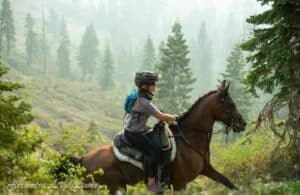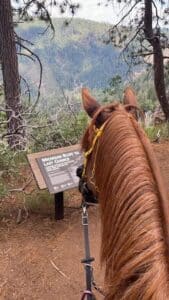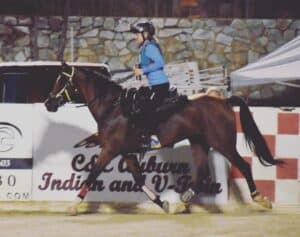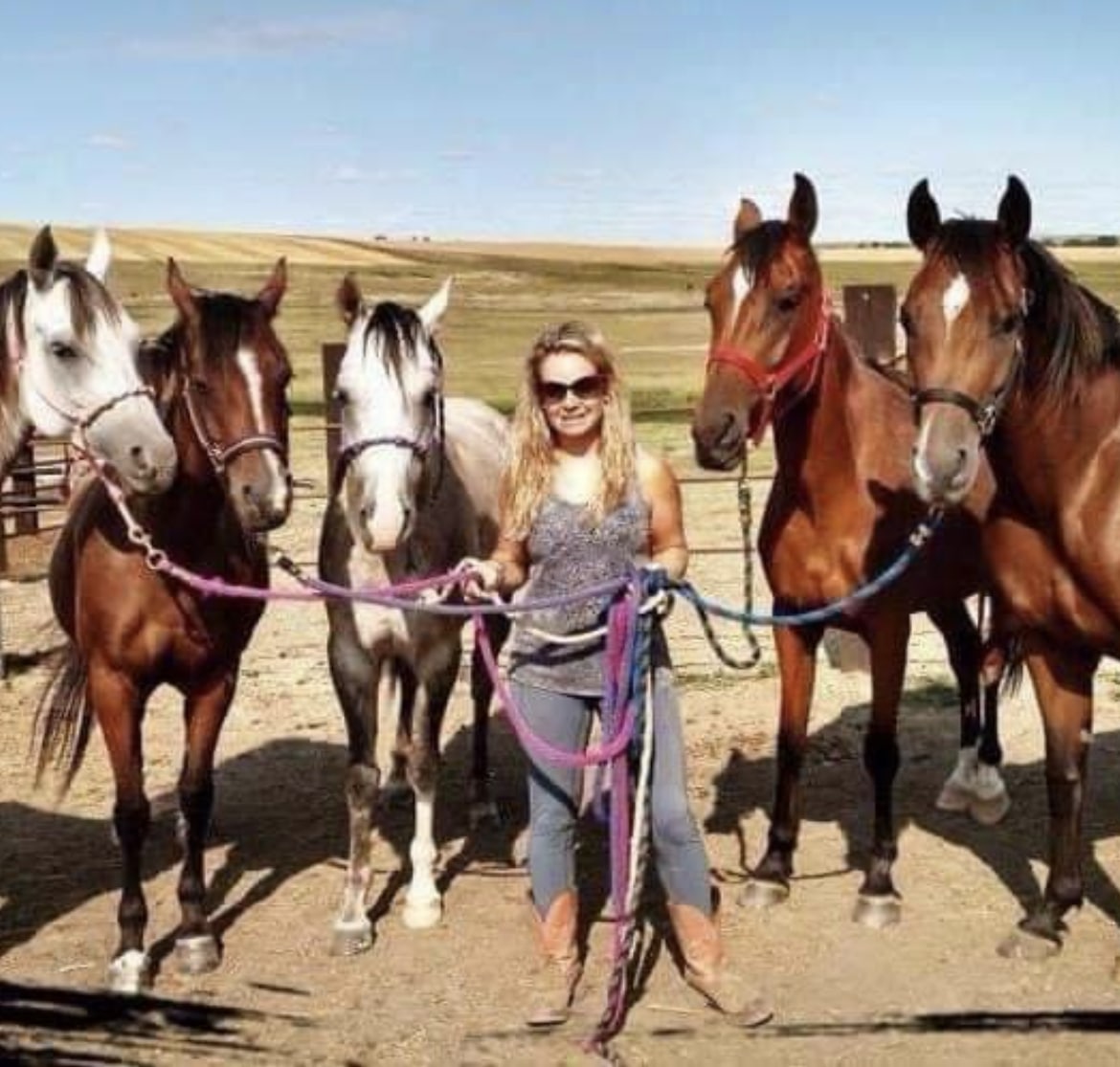It’s the Miles that Make the Horse: Endurance Riding

Perfect training grounds, the Badlands of North Dakota [Photo: submitted]
Pack the horses, pack the kids, don’t forget the dogs — let’s go on an adventure.
I can’t think of any other better way for us ‘horse lovers’ to experience and see the most gorgeous landscapes and natural beauty this earth has to offer, other than on a horse’s back. From riding through the woods in Minnesota, the Black Hills of South Dakota, the desert of Wyoming, the mountains in California, and the Badlands of the North Dakota: this is what endurance riding is all about — loving life and loving your horse.

LaPierre on some California extreme trails [Photo: Alexandra Leigh Lewis]
What once started off as a trail ride, quickly evolved into more… more riding, different trails. Your horse is doing so well and can go all day, then boom — let’s do an endurance ride. Let me tell you, that is only the beginning.
There are two main types of long-distance riding: competitive trail riding and endurance rides. In an endurance ride, the winning horse is the first one to cross the finish line while stopping periodically to pass a veterinary check that deems the animal in good health and fit to continue. As with human marathon running, many riders will participate to improve their horse’s personal best performance and consider finishing the distance with a proper vet completion record to be a “win.”
In the United States, most endurance rides are either 50 or 100 miles (160 km) long. Shorter rides called Limited Distance rides (LD) are organized for new riders to the sport or young horses being trained. However, LDs have evolved into a competition of their own, in which more experienced riders and horses also participate. There are also longer, usually multi-day, rides as well. In the United States, the American Endurance Ride Conference (AERC) sanctions endurance rides. In the United Kingdom, Endurance GB is the governing body. Winning riders can complete 100-mile (160 km) rides in 14 to 15 hours and even faster, while the cut off is a full 24 hours.
Any horse breed, even mules, can compete, but the Arabian generally dominates the top levels because of the breed’s stamina and natural endurance abilities.

LaPierre Competing in the desert of Namibia [Photo: submitted]
Growing up in South Africa, it has not always been easy for me to be in the horse industry. Now based in North Dakota, it is easier to not only own your own horse, but also follow your dreams! Since I can remember, I’ve always had to work hard for what I truly loved, and if it meant mucking out stables at our local riding center to earn a free lesson or riding some more difficult horses — just to be on a horse’s back, that is what I did. Because one thing was certain from as little as I can remember, I have always loved horses, and they are truly my purpose in life.
I started doing endurance riding, because riding a horse for one hour just wasn’t enough for me. I wanted what a lot of women want… more… LOL. Tacking up my horse and setting out to explore new trails. This truly was my church, on the back of a horse and being in nature. To me endurance riding was not only a new challenge, but also a way of having purpose for all the hours in the saddle and hard work I have been putting into my horses. Not only do you get to meet horse passionate people like yourself, but the opportunity to ride and see the most beautiful countryside all around the world!

Zeus and LaPierre in the Western States Trail in California on a training ride [Photo: submitted]
The idea of competing at an endurance event may seem daunting at first, but careful preparation will ensure the most enjoyment for yourself, as well as your horse. When preparing for endurance events, there are a few fitness factors to keep in mind and a horse’s conditioning process for competition generally focuses on three distinct but complementary areas:
- Cardiovascular fitness — the ability of his respiratory, cardiovascular, and muscular systems to produce energy.
- Musculoskeletal strength — the power or endurance of the muscle groups that are essential to the performance of his sport.
- Suppleness — the range of motion of joints, which can make a horse more athletic, improve the aesthetics of his performance, and reduce the risk of injury.
Long hours in the saddle are very beneficial to young horses, not only to get their legs hardened, but also for their minds. With older endurance horses, it is easier to give them a few months off because with the muscle they have gained throughout the years of training, they regain their fitness quick. Younger and upcoming endurance horses take a little bit more work as you are still in the process of building their muscles, heart, and lungs. It’s better to keep them going if you can throughout the year, even if it’s just riding in the arena and doing schoolwork.

Hundred mile finish line at the Tevis Cup [Photo: submitted]
As in all sports, there is an off-season. For us living in the North where it snows during the winter months and the temperature is cold, it means our horses are resting during these times. While older endurance horses have muscle memory, meaning it doesn’t take them too long to regain fitness again once the season starts, younger horses will need some extra conditioning. We like to keep them going during winter and haul to an indoor arena, mainly focusing on schooling and suppleness. This is also a great time to sort out small niggles and give your horse a rest period to recover from any injuries or strain. Rest is physically and mentally worthwhile for any horse competing in sport. And this is true for riders as well.
Currently, I have 4 endurance horses. My competitive endurance season normally starts in April/May and ends in October. To be ready for the season, I need to start training at least two months prior, which is March.
This is my most challenging month to start training, since it’s cold and as they say — I have to put my ‘big girl’ winter overalls on to be able to do the job. However, I have a saying — “what you put in is what you will get out,” and so far, I have been very blessed with my achievements over the years. The hardest part for me is when the season ends and the cold weather sets in. I go from riding every day to no riding at all.
During this time, I try to stay fit by going to the gym and work hard to secure my finances for the upcoming events. I pay regular visits to the barn to check my horses, trim their feet, secure their blankets, or feed them a hearty mash. Some days I just need to be around my horses to remind me of how lucky I am to share the trails with them and to give me something to dream about until my first spring ride!
For more information on getting involved in endurance riding, visit aerc.org

Dante Fourie LaPierre has been riding endurance horses since she was 8 years old. She has competed all over the world, including Dubai, England, Bahrain, France, Scotland and other parts of Europe. Making her home in Halliday, N.D., the horsewoman trains throughout North Dakota and travels to compete in parts of the U.S. including California, Wyoming, South Dakota, and Minnesota with her daughter Katya LaPierre and their herd of endurance horses.
